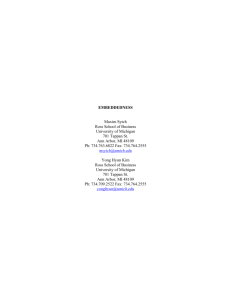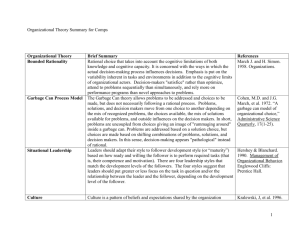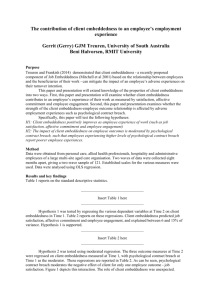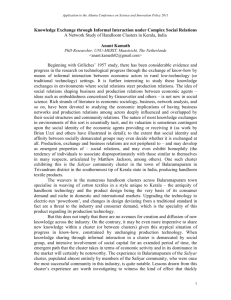STREAM NOTES To Aid In Securing Favorable Conditions of Water Flows
advertisement
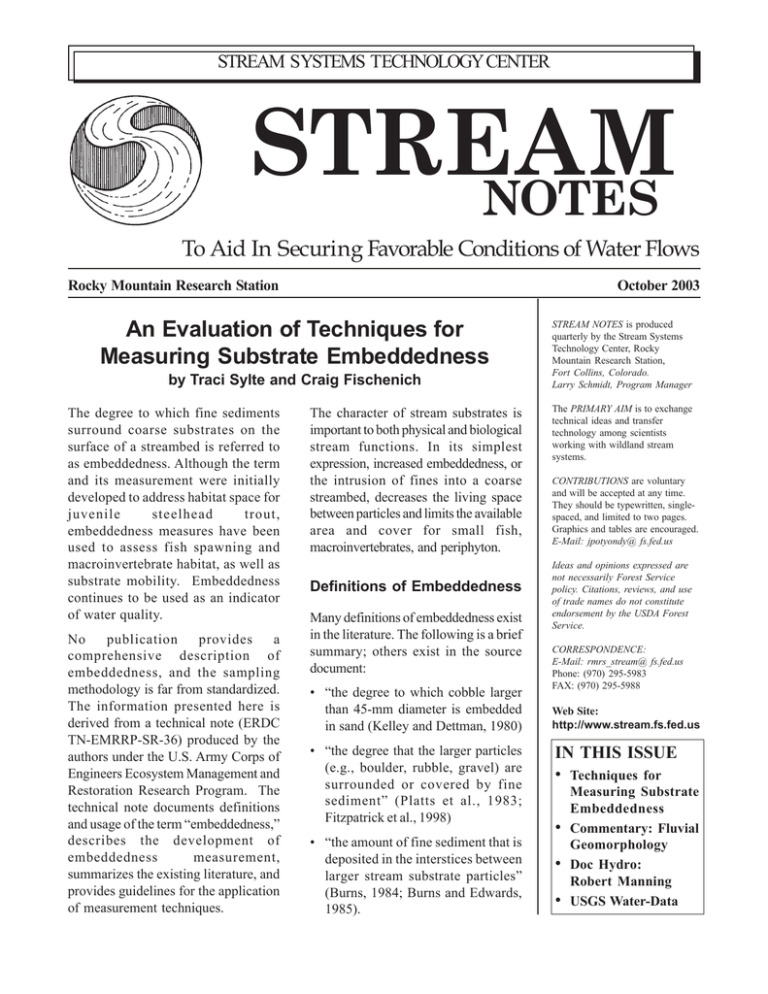
STREAM SYSTEMS TECHNOLOGY CENTER STRENOTES AM To Aid In Securing Favorable Conditions of Water Flows Rocky Mountain Research Station October 2003 An Evaluation of Techniques for Measuring Substrate Embeddedness by Traci Sylte and Craig Fischenich The degree to which fine sediments surround coarse substrates on the surface of a streambed is referred to as embeddedness. Although the term and its measurement were initially developed to address habitat space for juvenile steelhead trout, embeddedness measures have been used to assess fish spawning and macroinvertebrate habitat, as well as substrate mobility. Embeddedness continues to be used as an indicator of water quality. No publication provides a comprehensive description of embeddedness, and the sampling methodology is far from standardized. The information presented here is derived from a technical note (ERDC TN-EMRRP-SR-36) produced by the authors under the U.S. Army Corps of Engineers Ecosystem Management and Restoration Research Program. The technical note documents definitions and usage of the term “embeddedness,” describes the development of embeddedness measurement, summarizes the existing literature, and provides guidelines for the application of measurement techniques. The character of stream substrates is important to both physical and biological stream functions. In its simplest expression, increased embeddedness, or the intrusion of fines into a coarse streambed, decreases the living space between particles and limits the available area and cover for small fish, macroinvertebrates, and periphyton. Definitions of Embeddedness Many definitions of embeddedness exist in the literature. The following is a brief summary; others exist in the source document: • “the degree to which cobble larger than 45-mm diameter is embedded in sand (Kelley and Dettman, 1980) • “the degree that the larger particles (e.g., boulder, rubble, gravel) are surrounded or covered by fine sediment” (Platts et al., 1983; Fitzpatrick et al., 1998) • “the amount of fine sediment that is deposited in the interstices between larger stream substrate particles” (Burns, 1984; Burns and Edwards, 1985). STREAM NOTES is produced quarterly by the Stream Systems Technology Center, Rocky Mountain Research Station, Fort Collins, Colorado. Larry Schmidt, Program Manager The PRIMARY AIM is to exchange technical ideas and transfer technology among scientists working with wildland stream systems. CONTRIBUTIONS are voluntary and will be accepted at any time. They should be typewritten, singlespaced, and limited to two pages. Graphics and tables are encouraged. E-Mail: jpotyondy@ fs.fed.us Ideas and opinions expressed are not necessarily Forest Service policy. Citations, reviews, and use of trade names do not constitute endorsement by the USDA Forest Service. CORRESPONDENCE: E-Mail: rmrs_stream@ fs.fed.us Phone: (970) 295-5983 FAX: (970) 295-5988 Web Site: http://www.stream.fs.fed.us IN THIS ISSUE • Techniques for • • • Measuring Substrate Embeddedness Commentary: Fluvial Geomorphology Doc Hydro: Robert Manning USGS Water-Data Figure 1. Schematic representation of embeddedness. • “the extent to which larger particles are buried by fine sediment” (MacDonald et al., 1991). • “the ‘depth to embeddedness’ is the distance from the top of the rocks on the bed surface down to the top of the layer of fines in which the cobbles are embedded” (Osmundson and Scheer, 1998). Embeddedness measures the degree to which larger particles are covered with finer particles – a length term representing a volume of fines surrounding coarser substrates, which is often placed in a relative proportion to rock height in the plane of embeddedness (Fig. 1). Moreover, “fines” are commonly not defined even though the nature and degree of impact depends upon the size and the character of the sediments filling interstitial voids. Misconceptions arise because embeddedness is conceptually appealing as an index of impact even though a precise consistent definition is lacking. Embeddedness Measurement Methods Klamt (1976) and Kelley and Dettman (1980) originally introduced the concept of embeddedness. Klamt estimated the degree to which key rocks or dominant rocks in streams were embedded by using 25, 50, and 75 percent embeddedness levels. Kelley and Dettman focused on juvenile steelhead rearing habitat and quantified the depth of sand particles surrounding cobble-sized substrate in glide, glide/riffle, and riffle habitat units. Several methods have since been developed to measure or characterize embeddedness and are summarized in Table 1. Some of these rely on visual estimation while others measure and compute embeddedness as a percent. Recommended sample sizes range from as few as 15 to as many as 400 particles. Sampling may occur at locations that meet specific fish habitat criteria or span entire stream reaches. Because of this diversity in technique, comparing embeddedness values from one application to another is ill advised. Burns (1984) and Burns and Edwards (1985) essentially developed the embeddedness measurement method commonly employed. Skille and King (1989) later advanced the technique to apply it to stream analysis beyond fish habitat and strengthened its statistical rigor. However, this work has not been published. Burns (1984) used embeddedness to refer to the proportion of a large individual particle that was surrounded by fine sediment. The size of large particles considered was 4.5 to 30.0 cm in greatest diameter, and fine sediment was defined as particles less than 6.3 mm diameter. Burns and Edwards (1985) calculated the proportion by dividing the embedded depth (De) by the total depth (Dt) of the particle lying perpendicular to the plane of embeddedness (Fig. 1). Burns used a 60-cm-diameter steel hoop to define particles in the substrate to be measured, a 30-cmtransparent ruler to measure particle dimensions, and a float and a stopwatch to measure water velocity. Embeddedness Application Limits In 1988, Forest Service fisheries biologists and hydrologists united to review embeddedness literature, share experiences, and refine methods. Results of the standardization effort, found only in agency correspondence documentation, identify several important application limitations. STREAM SYSTEMS TECHNOLOGY CENTER METHOD MODE SAMPLE NUMBER LOCATION DESCRIPTON Platts et al.; Bain & Stevenson Visual General sample design guidance; no specifics for embeddedness Thalweg or mid-channel 5 embeddedness classes: 0-5. 5-25, 25-50, 50-75, 75-100% U.S. Environmental Protection Agency EMAP Kaufmann et al. (1999) Visual 55 5 estimates at 11 crosssections 10-cm samp ling area at 0, 25, 50, 75, 100% of cross-sectional wetted width U.S. Geological Survey NAWQA Fitzpatrick et al. (1998) Measured 3 transects; 5 gravel to b oulder sized substrates examined at each Not specified Nearest 10 percent opf embedded depth per particle is averaged Burns; Burns & Edwards Measured 100-400 individual paticle depending on desired standard deviation from the mean Specific fish habitat depth and velocity criteria Random 60-cm hoop toss into area meeting depth/velocity criteria; hoops tossed until sample particle number is attained Burns-Skille-King Measured Statistically determined; typically 20 random hoops; 3 hoops/transect typ ically result in =100 samp les/transect Bank to bank transects spanning a reach length of =20 times average stream width Focused on stream-re lated questions; improved statistics by averaging ind ividuals within the hoop and then averaging the transect U.S. Fish & Wild life Service Osmundson et al. (1998) Measured 20 measurements/site Minimum o f 1 run and riffle/site; specific depth and ve locity criteria wad ing parallel to shoreline Measure depth to embeddedness (DTE); 20 DTE are d ivided by med ian rock width of the site and then averaged for the reach • Cobble embeddedness exhibits high spatial and temporal variability in both natural and disturbed streams. Sampling must be intensive to detect changes. • Cobble embeddedness should be a measured parameter. However, visual assessments may provide information adequate for characterization purposes. • Embeddedness measurements are most applicable in granitic watersheds or other geologies where sand is an important component of the annual sediment load and substrate. • Cobble embeddedness is best applied to streams where embeddedness is suspected or known to limit salmonid rearing. • Repeat monitoring must be conducted at the same site because of high instream variability. • Application of the method in streams less than 20 feet wide may destroy sites for future monitoring (Fig. 2) • Cobble embeddedness is most appropriate for stream-to-stream comparisons of similar reachesor for measuring temporal changes in the same reach. Figure 2. Typical disturbance of the streambed with the Burns-Skille-King method showing removal of cobbles within the sampling hoop. STREAM SYSTEMS TECHNOLOGY CENTER Kramer (1989) identified several additional limitations to the embeddedness methodology and concluded that the techniques developed by Burns (1984) and Skille and King (1989) failed to accurately portray the true nature of temporal sediment changes in a channel. Kramer simulated conditions where fine sediment levels were increased and found that percent embeddedness actually decreased with increasing fine materials in some situations. This occurs because rocks that become 100 percent embedded are no longer measured; i.e., the total rock count is reduced and calculated percent embeddedness of the sample decreased (Fig. 3). only four of eight pairings of habitat units between developed and undeveloped streams. Potyondy (1993) in one of the most rigorous of all embeddedness studies summarized the results of cobble embeddedness analyses conducted on 120 streams in the Idaho Batholith on the Boise National Forest (Potyondy 1988) using the Burns (1984) measurement methodology. Potyondy found no statistical differences among streams in watersheds with various degrees of land-disturbing impacts from timber harvest, road construction, grazing, and mining. Stream embeddedness levels appeared to be more closely related to estimated natural sediment yields related to geology rather than to management activities occurring in the watersheds. Current Application t3 = 0.00 + 0.50 + 0.00 + 0.66 = 58% embeddedness t2 = 0.85 + 0.40 + 0.85 + 0.50 = 65% embeddedness t1 = 0.50 + 0.25 + 0.50 + 0.33 = 40% embeddedness Figure 3. Example of simulated increases in embeddedness that might result from adding fines from level t1 to t3 that actually results in a reduction in the calculated embeddedness percentage. Few field projects currently use the Burns-Skille-King method. In the late 1980s and early 1990s, the method was widely used by the Payette, Boise, Nez Perce, Clearwater, Helena, Deerlodge, Bitterroot, and Lolo National Forests. We conducted a brief literature review of the current use of embeddedness in the United States and found that embeddedness remains a common monitoring technique in at least 17 states and is present as a water quality criterion where legal implications, such as Total Maximum Daily Load (TMDL) issues, may ensue. Relation of Embeddedness to Management Activities Although embeddedness is still widely used as a substrate measurement, certain negative aspects are apparent. These include the following: The ability of embeddedness to detect changes due to land management activities is unclear and results have rarely been published in peer reviewed literature. Burns (1984) sampled embeddedness in 19 tributaries of the South Fork of the Salmon River with varying levels of development. He found that streams with more development had statistically significant higher mean embeddedness than undeveloped or partially developed streams. Partially developed and undeveloped streams were not significantly different from each other. Munther and Frank (1986) quantified conditions in Montana streams and found significant differences in • • Significant differences exist in methodologies. • Fundamental defects exist such that a change in approach is necessary. Published guidance fails to provide the appropriate detail needed for field application. Without additional research addressing the reliability of embeddedness outputs from the various methods, use of embeddedness as standards and guidelines or to link embeddedness to biological criteria currently appears highly questionable. STREAM SYSTEMS TECHNOLOGY CENTER References Bain, M. B., and Stevenson, N. J., eds. (1999). Aquatic habitat assessment: Common methods. American Fisheries Society, Bethesda, MD. Burns, D. C. (1984). An inventory of embeddedness of salmonid habitat in the South Fork Salmon River drainage, Idaho, Unpublished paper, USDA Forest Service, Payette National Forest, McCall, ID. Burns, D. C., and Edwards, R. E. (1985). Embeddedness of salmonid habitat of selected streams on the Payette National Forest, USDA Forest Service, Payette National Forest, McCall, ID. Fitzpatrick, F. A., Waite, I. R., D’Arconte, P. J., Meador, M. R., Maupin, M. A., and Gurtz, M. E. (1998). Revised Methods for Characterizing Stream Habitat in the National Water-Quality Assessment Program, WaterResources Investigations Report 98-4052, U.S. Geological Survey, Raleigh, NC. Kaufmann, P. R, Levine, P., Robison, E. G., Seeliger, C., and Peck, D. V. (1999). Quantifying Physical Habitat in Wadeable Streams, EPA/620/R-99/003. U.S. Environmental Protection Agency, Washington, DC. Kelley, D. W., and Dettman, D. H. (1980). Relationships between streamflow, rearing habitat, substrate conditions, and juvenile steelhead populations in Lagunitas Creek, Marine County, 1979, Unpublished Report, Marine County Water District, CA. Klamt, R. R. (1976). The effects of coarse granitic sand on the distribution and abundance of salmonids in the central Idaho Batholith, M.S. thesis, University of Idaho, Moscow. Kramer, R. (1989). Evaluation and revision of the hoop method for monitoring embeddedness, Unpublished Report, Lolo National Forest, Missoula, MT. MacDonald. L. H., Smart, A. S., and Wissmar, R. C. (1991). Monitoring guidelines to evaluate effects of forestry activities on streams in the Pacific Northwest and Alaska, EPA/910/9-91-001, United States Environmental Protection Agency, Water Division, Seattle, WA. Osmundson, D. B., and Scheer, B. K. (1998). Monitoring cobble-gravel embeddedness in the streambed of the upper Colorado River, 1996-1997, Final Report, U.S. Fish and Wildlife Service, Grand Junction, CO. Platts, W. S., Megahan, W. F., and Minshall, W. G. (1983). Methods for evaluating stream, riparian, and biotic conditions, General Technical Report INT-138, USDA Forest Service, Rocky Mountain Research Station. Ogden, UT. Potyondy, J. P. (1988). Boise National Forest cobble embeddedness baseline inventory: Results and relationship to management activities, Unpublished Report, Boise NF, Boise, ID. Potyondy, J. P. (1993). Relationship of fish habitat condition to management activities on granitic watersheds in Central Idaho, Hydrological Science and Technology 8(1-4), 117-122. Skille, J., and King, J. (1989). Proposed cobble embeddedness sampling procedure, Unpublished draft, Idaho Department of Health and Welfare, Division of Environmental Quality, and USDA Forest Service, Intermountain Research Station, Boise, ID. Traci Sylte is a Hydrologist, Lolo National Forest, Missoula, MT; tsylte@fs.fed.us; (406) 329-3896. Craig Fischenich is a Research Civil Engineer, US Army Engineers, Research and Development Center, Vicksburg, MS; craig.fischenich@erdc.usace.army.mil; (601) 634-3449. For more information about embeddedness see: Sylte, T.L., and Fischenich, J.C. (2002). “Techniques for measuring substrate embeddedness,” EMRRP Technical Notes Collection (ERDC TN-EMRRP-SR-36), U.S. Army Engineer Research and Development Center, Vicksburg, MS. Available online at: http://www.wes.army.mil/el/emrrp/pdf/ sr36.pdf STREAM SYSTEMS TECHNOLOGY CENTER Fluvial Geomorphology Train Is Leaving the Station; Shouldn’t We Be on Board? Commentary by J. Steven Kite “…bear with me while I share some thoughts on an issue that needs our collective attention immediately lest we lose influence and control over part of our discipline ... if we have not done so already. I am referring to applied aspects of fluvial geomorphology, a field that has been called “FGM” in some circles. A simplistic phrasing of the problem is that, if the overwhelming majority of research and academic fluvial geomorphologists continue to disregard the rapidly growing field of natural stream design, we will lose control of the direction of applied fluvial geomorphology and miss an opportunity provided by a plethora of hydraulic geometry data. One might argue that geomorphology applications rightfully belong in the field of civil engineering, but the evolving reality is that an expanding market is largely being filled by folks with very limited experience in hydrology or geomorphology, other than a series of workshops on fluvial geomorphology techniques, such as those taught by Dave Rosgen of Wildland Hydrology. These workshops fill an important void in conveying many basics of the discipline, standardizing methodology, and presenting solutions to common stream problems. Hundreds participate in these workshops annually … I’ll bet the number exceeds the total enrollment of all academic fluvial geomorphology classes in the USA … raising the awareness of how streams function to a large audience of nongeomorphologists from a variety of backgrounds. Several government agencies and NGOs have set completion of these workshops as a de facto requirement of natural stream design practitioners. However, I am sure that everyone will agree there is no way that workshops, no matter how well done, can take the place of in-depth experience such as that acquired through research in a degree program. It seems obvious that the best natural stream design practitioners should come from a pool of traditionally educated geoscientists with a true understanding of fluvial processes, hydraulic geometry, and the geologic controls of sediment supply. What are we academics doing to prepare our students to walk the natural stream design walk and talk the FGM talk? My conversations with colleagues suggest that the most common positions are to either dismissively criticize or to simply ignore it. My last review of basic geomorphology and fluvial geomorphology textbooks showed even the best tend not to address Rosgen’s stream classification and many of the other basic terms that regulators and environmental consulting firms assume are the lingua franca of stream work. Hence, today our intellectually well-prepared graduates are likely to sound illiterate to those who most need their guidance… and who might be in a position to offer them a job. Leaving streams untouched to recreate equilibrium conditions is not a viable solution to deteriorating stream channels in the modern socio-political climate. While this hands-off strategy may make all the sense in the world to those of us viewing through the lens of geologic time, “real” people demand action in a timely manner. Bulldozers and backhoes are already in the channels (especially in the aftermath of floods), and they have been there for a long time. The most viable professional solution for bad streams is for those of us who are knowledgeable to guide the path of mitigation and restoration. Misguided efforts by those who lack a depth of understanding are likely to fail sooner or later, and while these may make for some interesting field trip stops, the ecological costs can be unaffordably high. Unless we want to allow natural stream design principles to evolve detached from academic geomorphology, we need to ensure that our students are fluent in the field and understand its research needs. We should embrace Dave Rosgen for putting the discipline on the front burner of regulators and STREAM SYSTEMS TECHNOLOGY CENTER into the public eye. If we believe that some applied aspects of the field as currently implemented need to be done differently, then we should formulate alternatives and present them to practitioners with good forceful arguments.” Manning had no formal training in fluid mechanics or engineering. However, during his life he devoted considerable effort to the development of a simple, dimensionally homogeneous formula for openchannel flow. J. Steven Kite is an Associate Professor, Department of Geology and Geography, West Virginia University, Morgantown, WV 26506-6300; jkite@wvu.edu; (304) 293-5603 x4330. Manning began his diligent search for a useful formula by evaluating and comparing the seven best known open-channel flow formulae of the time with the idea that “by taking the mean results of all of them an approximation to the truth might be arrived at.” This is an excerpt of a commentary originally published under the title, “Message From the Chair” in the American Geological Society Fall 02-Spring 03 Newsletter fo the Quaternary Geologist and Geomorphologist Division. Dr. Kite was chair of the Quaternary Geologist and Geomorphologist Division at the time. The full text of the article can be found online at: http://rock.geosociety.org/qgg/ In 1885, Manning arrived at an equation of the form: V = CR S 2/3 1/ 2 Manning later rejected this formula because it required the extraction of a cube root (not a trivial concern at that time) and because it lacked dimensional homogeneity. So concerned was Manning with the issue of dimensional homogeneity that he proposed an alternative equation: ⎡ ⎤ 0.22 V = C gS ⎢ R + (R − 0.15m)⎥ m ⎣ ⎦ in which m is the barometric pressure in meters mercury. Dear Doc Hydro: We’re all familiar with Manning’s Equation, but who was Manning and how did he come up with the idea of a simple formula to compute velocity in streams? Incredible as it may sound, the originator of Manning’s equation, Robert Manning, was an accountant-turned-selftaught-engineer who changed his profession because of the Irish famine. It is obvious that his accounting background and pragmatism influenced his work. He had a strong drive to reduce problems to their simplest form and expressed disdain for mathematical formulations. Others, however, preferred the simpler equation and when it was found that “the reciprocal of C corresponds closely with that of n” the form of the equation we know today (in metric units) is the one that achieved widespread acceptance. V = 1 2 / 3 1/ 2 R S n More in-depth information about the development of the Manning’s equation can be found in: Fischenich, C. (2000). Robert Manning (A Historical Perspective), EMRRP Technical Notes Collection (ERDC TNEMRRP-SR-10), U.S. Army Engineer Research and Development Center, Vicksburg, MS. Available online at: http://www.wes.army.mil/el/emrrp/pdf/sr10.pdf STREAM SYSTEMS TECHNOLOGY CENTER STREAM NOTES STREAM SYSTEMS TECHNOLOGY CENTER USDA Forest Service Rocky Mountain Research Station 2150 Centre Ave., Bldg A, Suite 368 Fort Collins, CO 80526-1891 PRSRT STD POSTAGE & FEES PAID USDA - FS Permit No. G-40 OFFICIAL BUSINESS Penalty for Private Use $ 300 October 2003 IN THIS ISSUE • Techniques for • • • Measuring Substrate Embeddedness Commentary: Fluvial Geomorphology Doc Hydro: Robert Manning USGS Water-Data Reports STREAM NOTES USGS Water-Data Reports on the Web U.S. Geological Survey Water Resources Data reports for some of the individual states are now available as PDF files at the USGS web site http://water.usgs.gov/pubs/wdr/. Water-resources data reports are published for each state on an annual water year basis and typically contain records of stage, discharge, and water quality for streams; stage and water quality for lakes and reservoirs; meteorological data; and water levels and water quality for wells and springs. Over half of the states now make some of these data reports available to the public using this format although available years vary by state. The United States Department of Agriculture (USDA) prohibits discrimination in all its programs and activities on the basis of race, color, national origin, sex, religion, age, disability, political beliefs, sexual orientation, or marital or family status. (Not all prohibited bases apply to all programs.) Persons with disabilities who require alternative means for communication of program information (Braille, large print, audiotape etc.) should contact USDA’s TARGET Center at 202-720-2600 (voice and TDD). To file a complaint of discrimination, write USDA, Director, Office of Civil Rights, Room 326-W, Whitten Building, 1400 Independence Avenue, SW, Washington, DC 20250-9410 or call 202-720-5964 (voice or TDD). USDA is an equal opportunity provider and employer.

